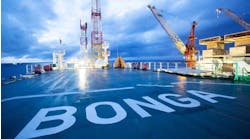Ian Verhappen
Industrial Automation Networks Inc.
Multi-phase fluid measurement is a difficult yet important component of any offshore production process. If you do not know what is being produced in terms of gas, hydrocarbon liquids, and water, it is almost impossible to be able to control the process and allocate production to the correct wells. Allocation is the basis on which all accounting and hence revenue is based so "getting it right" has significant incentive. Accuracy requirements for metering multi-phase fluids are approximately 5% to 10% for reservoir management, 2% to 5% for production allocation, and 0.25% to 1% for fiscal metering.
Composition of the hydrocarbon streams is normally determined from laboratory samples as it tends to change slowly over time from each well or location. Other stream characteristics such as water cut and gas/liquid ratio change rapidly and are therefore normally measured continuously, hence the reason for multi-phase flow meters.
The preferred measurement technique is to eliminate the need to separate phases using only a single flow measurement device. As a result, one technique is to modify the flow so that it becomes well mixed enough to appear homogeneous. The measurement then simplifies to a determination of phase fractions, normally calculated from models of the density of the different process fluids, and the overall velocity. Since mass equals density times volume, we can calculate actual production rates from this information and the principles of conservation of mass.
Traditional measurement techniques, which require a single-phase fluid, need separation of the three fluid phases (gas, hydrocarbon, water), and then recombination of at least the gas and hydrocarbon streams for transmission to onshore production/processing facilities. However, three-phase separators require sufficient real estate on the platform to separate the hydrocarbon and water phases, which depending on the specific gravity of the hydrocarbon phase and the large range of flow profiles that can develop from the individual wells can sometimes be quite large.
The development of online water cut measurement now makes it possible to separate the gas only for measurement purposes (a much simpler and smaller separator requirement) and then use the resulting measurements of gas and calculated water/oil content based on the water cut for oil and water production rates.
Additional measurement techniques have been developed for in-line meters, which do not require a separator. Due to the high capital and maintenance costs associated with these meters, there is an increasing reliance on software models both in the meters themselves and as the basis for virtual measurements to confirm the validity of the results. Eliminating the need for meters entirely is an active area of development.
There are about 20 companies that sell in-line multi-phase meters for use either onshore/on platform or subsea. These in-line meters commonly employ a combination of two or more of the following measurement technologies and techniques: electromagnetic measurement principles (microwave technology, capacitance, conductance, magnetic resonance); gamma ray densitometry or spectroscopy; neutron interrogation; differential pressure using venturi, V-cone or other restriction; positive displacement; ultrasonic; or cross-correlation of electromagnetic, radioactive, and ultrasound signals.
One of the challenges with many of the microwave water cut meters is that they are sensitive to changing salinity. However, for most offshore operations from a single reservoir this should only change slowly with time and be captured as part of the regular calibration processes.
Recent market forecasts indicate there are approximately 1 million producing wells worldwide with about 3,000 of these wells using multi-phase flow meters. This number is forecast to at least double this decade as the technology and market evolves and as producers gain more experience with this form of measurement device. Because many of these devices are more complex than the typical field instrument, a closer analogy in terms of complexity would be a process analyzer -- availability of the required level of field support is still in development, and the brunt of the load falls back to the manufacturer or in some cases the development teams. It is largely for this reason that the annual operating expense for a multi-phase meter is about 25% of the cost of the meter itself for the first year, then $10,000-$40,000/year for both onshore and topsides applications.
The same market study documented that the incentive for developing these systems is substantial, since a subsea multi-phase meter in a tieback development 10 km (6 mi) from the host platform could reduce capex by an estimated 62% because of the elimination of test lines. The meter also would improve production system management, increasing the amount of oil recovered by 6%-9%.
The incentive is certainly there; however, the conservative nature of the oil and gas industry, and especially the offshore component, where the risk of error is so high, means that everyone tends to wait for someone else to "prove it works" before trying it themselves. Therefore, the time between good idea, product, and market can be as much as a decade or more. Multi-phase meters were initially developed in the 1990s and at present have less than 5% market penetration, thus showing we are true to our history, despite the potential rewards.
As the technology continues to evolve, and the need to better and more quickly understand the nature of the offshore production process so that it can be more controlled to optimize production, increase safety, and reduce environmental risk, the author is confident that multi-phase flow and its measurement will be a key contributing factor to that success.
The author
Ian Verhappen, P.Eng. is an ISA Fellow, ISA Certified Automation Professional, and a recognized authority on Foundation Fieldbus and industrial communications technologies. Verhappen provides consulting services in the areas of field level industrial communications, process analytics and hydrocarbon facility automation. Feedback is always welcome via e-mail at[email protected].
Reference
Gioia Falcone, Texas A&M University, Bob Harrison, Soluzioni Idrocarburi srl, "Forecast expects continued multiphase flowmeter growth," Oil & Gas Journal, 03/07/2011http://www.ogj.com/articles/print/volume-109/issue-10/drilling-production/forecast-expects-continued-multiphase-flowmeter-growth.html (2013-08-11)


